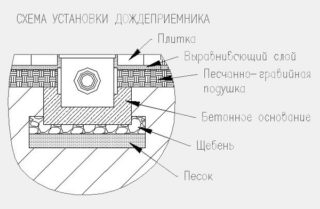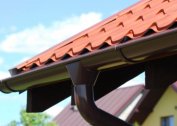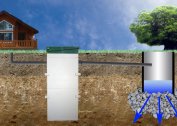Accumulation of rainwater on the site can erode the foundation, fill the basement. In addition, frequent rains have a negative effect on fertility. This happens as follows: organic or mineral fertilizers introduced into the soil are washed out into the lower layers of the soil, from where the root system of plants cannot get them, so you can’t count on the increase in yield. Solve the problem will help do-it-yourself rain sewer.
Definition and purpose of storm sewers
Storm sewage is a system of above-ground and underground communications from pipes, which diverts exclusively rainfall. Stormwater should be independent of fecal effluents, since with a large amount of precipitation there is a risk of flooding the site with waste products.
If the storm drainage system in a private house is designed only for clean rain and melt water, then pipes can be diverted directly into the body of water, if there is one nearby. In urban systems, not quite clear water from industrial enterprises is often discharged into stormwater. It requires additional filtering.
Depending on the climate, up to 100 cubic meters of water is poured onto the roof of a private house a year, and even more on a plot. Constant humidity in the basement can cause mold and foul odors. The room will not have time to dry over the summer, since the degree of ventilation and lighting of the basement is always lower than aboveground buildings.
The principle of operation of storm sewers is to collect precipitation and transport it through pipes or gutters to a sump, well or storm water inlet, and then beyond the boundaries of the site. Additional devices are sand traps, grease traps, filters.
In a simple system there are only above-ground devices for collecting water and a storm water inlet, the liquid from which is used in hot weather for watering plants. It is convenient and economical.
Types and device of storm sewer for a private house
For a private home, one of the three types of rainfall is relevant:
- underground;
- aboveground;
- mixed.
An underground system is laid at the stage of planning a building plot. It will be cheaper. If you build the underground communications after construction, you will have to dig through the entire yard, which will create inconvenience to the residents. At the stage of building a house, it is better to immediately do all three types of sewage - fecal, drainage and stormwater.
Advantages of underground stormwater:
- does not take a place;
- looks aesthetically pleasing;
- you can install non-freezing pipes or make the laying of pipes deeper.
Cons: a large amount of work and cost.
When laying pipes, in order to calculate the amount of work, it is necessary to take into account climatic conditions: to what depth does the soil freeze in winter.
Overhead communications is easier to equip. These are special gutters mounted in a street covering through which water flows into settling tanks or ditches. If the house is located higher than the garden, then you can send rainwater to a container in the garden from which it will be used for irrigation.
The mixed drainage system is planned in such a way that part of the communications is underground, and part on the surface. This is the most convenient and less expensive option. For each site, sewage and stormwater are planned individually.
Structural elements
 Storm sewage may consist of the following elements:
Storm sewage may consist of the following elements:
- Well, where water flows from the entire site. Its volume depends on the amount of precipitation in a particular region. It can be a plastic sealed canister with a hatch or a well of concrete rings dug into the ground.
- Point receivers, which are installed in places where water stagnates most often. They can also be concrete or plastic and are installed in the ground to a certain depth.
- Line channels. Settled along the tracks, begin near the water receivers from the roof. Equipped with steel, aluminum or cast iron grilles.
- Sand traps. Plastic cases that need to be cleaned periodically. Large particles settle in them. Prevent clogging of storm sewers.
- Viewing channels located along the pipe installation. With their help it is convenient to clean the system.
In a private house, all the elements are not always installed - it depends on the size of the plot and the amount of rainfall per year.
Current requirements for installing stormwater
Before starting to equip storm sewers in a private house, the following indicators are taken into account:
- whether the liquid needs additional purification or whether it can be drained into water bodies;
- what type of soil is typical for this area: on sandy soil, water is absorbed quickly, and clay practically does not let liquids pass through, so another way of disposal is needed;
- Sewerage must be removed at least 1 m from underground utilities - electrical cables and gas pipelines;
- if it is not possible to observe the required pipe slope, install drainage pumps that will push the fluid into the sump.
The terrain is important from the point of view of installing the well - it should be at the lowest point of the site. Thus, it will be easier to comply with the guidelines for pipe slope and to avoid flooding of the territory with a large amount of precipitation.
Design and implementation of necessary calculations
 Before starting work, you need to make a project. If you do not want to contact professional plumbers, then you need to draw a plan for yourself, given where the ground level is higher.
Before starting work, you need to make a project. If you do not want to contact professional plumbers, then you need to draw a plan for yourself, given where the ground level is higher.
The sump well must be located at the lowest point of the site. All pipes should have a slope of at least 3% - 3 cm per linear meter so that the water does not stagnate, but quickly flows into the well.
Projects are prepared taking into account:
- Topographic plan of the area.
- Soil research data.
- Construction objects.
- The technical conditions of connection to the central sewage system, if such are assumed.
- Customer wishes.
It is advisable to entrust the preparation of the plan to specialized companies, since improvements and alterations are associated with high costs and loss of time.
Material selection
The main element of stormwater around the house are pipes.
- From polyvinyl chloride: have a smooth surface inside, are not exposed to bacteria and moisture. They are easy to install, as they have seals at the joints for greater tightness. Equipped with corner joints so that you can lay them in accordance with the plan. Suitable for underground utilities at a depth of 4 m.
- Polypropylene: have a higher strength than PVC. The inner surface does not clog, as it has a smooth surface. The outer shell is corrugated, which makes it possible to bend the pipe, facilitating installation.
- Asbestos-cement: durable, but can crack when hit, so installation must be done carefully. Suitable for surface drainage, as they have low thermal conductivity, and the water in them does not freeze at low temperatures. Of the shortcomings - it is difficult to complete the joints.
- From fiberglass: used at large facilities. A diameter of 50 cm is capable of providing high throughput.O-rings are used for joints, which eventually deteriorate and require replacement.
Water receivers are selected by bandwidth. They are mainly made of plastic, but sometimes metal products are used if the load on the soil exceeds the norm.
Trays and gutters are made of metal, concrete, plastic. For a private area with a small load, cheaper plastic models are suitable. For urban communications - concrete or metal.
Installation Steps
 After preparing the plan, installation of the storm sewer is started. It begins with the installation of gutters around the house under the roof. Then the pipes go down to a point called a storm water inlet, which is deepened into the ground. After external work, they begin to lay either underground pipes and gutters, or above-ground devices that divert precipitation into a common well.
After preparing the plan, installation of the storm sewer is started. It begins with the installation of gutters around the house under the roof. Then the pipes go down to a point called a storm water inlet, which is deepened into the ground. After external work, they begin to lay either underground pipes and gutters, or above-ground devices that divert precipitation into a common well.
Underground communications:
- Dig a trench, observing the depth and slope for the pipes.
- Pour a pillow of sand to the bottom.
- Lay pipes and other parts of the system, connecting in a single design.
- Connect the storm sewer to the well.
- Before filling the trenches, check the system for leaks. To do this, rinse from the roof with a hose.
- To fill up and compact the soil.
The simplified above-ground drainage system also provides a bias towards lowering the level of the site, but the gutters are located on the surface of the earth. Rainwater is either discharged into a street common ditch or into a garden.
Operation and maintenance
Underground communications require attention, since after many years of operation they are silted up. Once every 3 to 4 years, a thorough cleaning and washing of sand traps and collectors is required. In a common well, sludge is formed at the bottom, which can impede the free passage of sewage into the soil.
Cleaning is carried out using fecal pumps that can pump dirty water and grind large particles if necessary. To begin with, the liquid is completely removed, then the well is filled with water and the contents are again pumped out until the bottom is clean of mud deposits.
Complete flushing of pipes and wells with pneumatic installations is carried out once every 10 years.
1 - 2 times a season it is recommended to take out and wash the nets in the storm water inlets, since dust and dirt from the roof settles precisely at these points.
If filters are installed in the system, they must be changed in accordance with the recommendations of the manufacturers.
Cost of storm sewers
The estimate of storm sewers includes the cost of the project, materials, rental equipment and the work of builders.
The preparation of the project has its own nuances, which are the complexity of the relief of the site, its length.
Materials can be selected from the middle price segment or expensive. Depends on what kind of load falls on the soil and how large the catchment area is. All components are taken into account - roof drains, storm water inlets, gratings, gutters, underground pipes, installation of drainage inspection wells, as well as the cost of the capacity for a well or concrete rings.
To install heavy asbestos-cement and concrete structures will require special equipment. When working with a company, rent will cost more than the help of a neighbor. The same goes for the hourly wage of the construction team. Here you need to decide how quickly you need to equip the storm.
Professional workers will do everything quickly and efficiently, which is much more reliable and cheaper than subsequently redoing improperly executed underground laying of communications.






